Read about what head and neck cancer is, types of head and neck cancer, risk factors for head and neck cancer and symptoms of head and neck cancer.
Download the complete head and neck cancer booklet
Our new booklet 'Understanding head and neck cancer' is available now.

Download section one of our head and neck cancer booklet: Understanding head and neck cancer
Head and neck cancer is a general term for a range of cancers that start
in the tissue or lymph nodes in the head and neck area.
• The main risk factors for head and neck cancer are drinking alcohol and
using tobacco.
• Human papilloma virus (HPV) can increase the risk of cancers in the
tongue, tonsil, and throat (oropharynx).
• The symptoms of head and neck cancer can be different from person to
person. It is important to have your GP or whānau doctor check any
symptoms:
• A lump (or lumps) in the neck can be the first sign of head and neck
cancer. These lumps are generally painless and may slowly get bigger.
• Some head and neck cancers cause pain, coughing, or changes in
swallowing, hearing, vision, or speaking.
He rerenga kōrero whānui te matepukupuku upoko me te kaki mō te
whānui ō ngā matepukupuku ka tīmata ki te kiko, ki ngā tīpona waitinana
rānei kei roto i te upoko, i te kaki rānei.
• Ko ngā āhuatanga mōrearea matua mō te matepukupuku upoko me te
kaki, ko te mahi inu waipiro me te momi tupeka.
• He Wheori te Human papilloma virus (HPV) tērā e whakapiki ake i te
mōrearea o te puta o ngā matepukupuku ki te ārero, te miramira, me te
korokoro (oropharynx).
• Tērā pea he rerekē ngā tohumate o te matepukupuku upoko me te kaki
mai ia tangata, ki ia tangata. He mea nui rawa kia tirohia e tō GP, tō
tākuta whānau rānei, ki te tirotiro i ngā tohumate:
• He tohu tuatahi pea tētahi puku ki te kaki, o te matepukupuku upoko
me te kaki rānei. I te nuinga o te wā, noho mamae-kore ai ēnei puku,
ā, tērā pea ka piki iti haere nei.
• Tērā ētahi matepukupuku upoko me te kaki e puta ai he mamae, he
maremare, he rerekētanga ki te mahi horomi, te mahi whakarongo, te
mahi kite me te mahi kōrero.

What is head and neck cancer?
Head and neck cancer is a general term for a range of cancers that start in the
tissue or lymph nodes in the head and neck area. It includes cancers of the:
• mouth
• tongue
• throat (nasopharynx, oropharynx, and hypopharynx)
• voice box (larynx)
• nose and sinuses
• salivary glands
• skin of the head and neck (including the scalp and ear)
• thyroid.
Cancer that starts in the brain, eye, oesophagus (food pipe), or bones of the head/spine is not usually considered head and neck cancer.
In this booklet, head, neck, and mouth cancer are referred to as head and neck cancer.
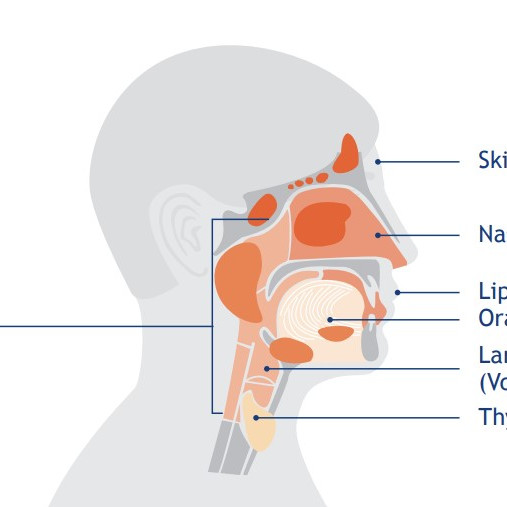
This image was produced by Cancer Council Australia and is used and adapted with permission.
How head and neck cancers get their names
Head and neck cancers are named after the part of the body where they start.
Cancer that starts in the mouth is called oral cancer. The mouth includes the lips, tongue (the front bit you can see), gums, cheeks, roof of your mouth (hard palate) and floor of your mouth (under your tongue).
This image was produced by Macmillan Cancer Support and is reused with permission
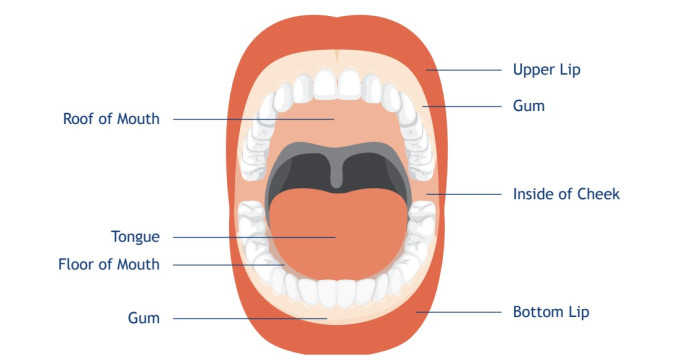
The tongue has two parts:
• The part you can see (the oral tongue)
• The part that disappears into the back of your throat and that you cannot see (the base of the tongue)
Cancer on the part of the tongue that you can see is called oral cancer.
Cancer on the part of the tongue that you cannot see is called oropharyngeal cancer.
The throat (pharynx) has three main parts:
• Nasopharynx
• Oropharynx
• Hypopharynx
Find out more about throat cancer
Nasopharynx:
The nasopharynx is the top part of the throat that starts behind the nose. Cancer that starts in this space is called nasopharyngeal cancer.
Oropharynx:
The oropharynx is the middle part of the throat that starts behind the mouth. It includes the soft part of the roof of the mouth (soft palate), the part of the tongue you cannot see (tongue base), the tonsils, and the back and side walls of the throat. Cancer that starts in this space is called oropharyngeal cancer. Many oropharangeal cancers are linked to the Human Papilloma Virus (HPV).
Hypopharynx:
The hypopharynx is the bottom part of the throat that sits behind the voice box (larynx). Cancer that starts in this space is called hypopharyngeal cancer.
This image was produced by Cancer Council Australia and is used and adapted with permission.
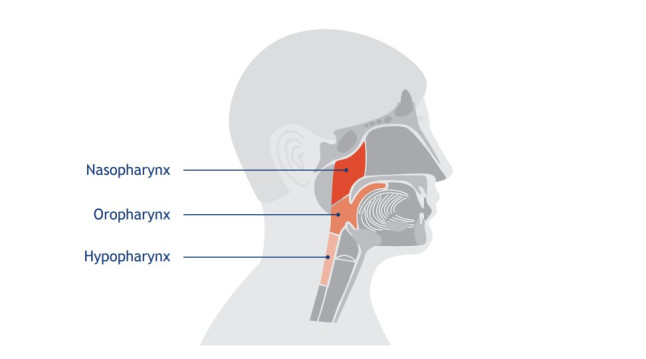
Laryngeal cancer affects the larynx. Your larynx is more commonly called your voice box and has two vocal cords inside. When the air you breathe moves past the vocal cords they vibrate—this is how you make different sounds when you speak.
The larynx sits near the entrance to your airway (trachea) in your neck. The epiglottis acts as a flap to cover the trachea when you swallow. This stops the food you eat and drink entering your lungs.
The larynx has three parts:
• Supraglottis—the space above the vocal cords
• Glottis—the middle of the larynx where the vocal cords are
• Subglottis—the space below the vocal cords that attaches to your airway
This image was produced by Cancer Council Australia and is used and adapted with permission.
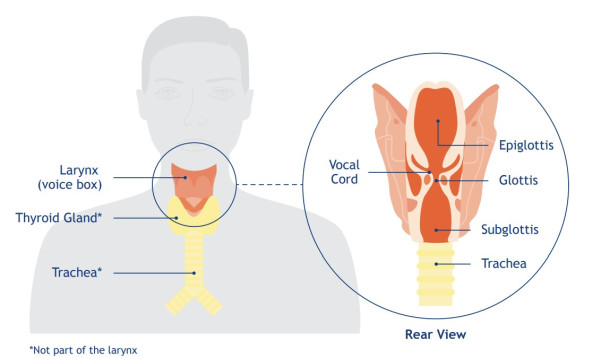
Cancer that starts inside the nose or in the paranasal sinuses is called nasal and sinus cancer.
The space inside the nose is called the nasal cavity. This space warms, moistens, and filters the air that you breathe.
The bones around the nasal cavity have small, hollow spaces in them called paranasal sinuses. The sinuses affect the tone and sound of your voice.
There are usually four pairs of paranasal sinuses (some may be missing or not fully developed):
• Frontal sinuses—behind the forehead
• Ethmoid sinuses—above the nose and between the eyes
• Sphenoid sinuses—behind the nose and between the eyes
• Maxillary sinuses—under the eyes and in the cheek area
This image was produced by Cancer Council Australia and is used and adapted with permission.
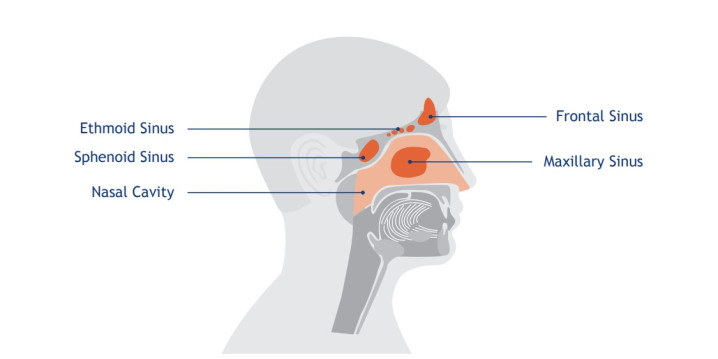
Cancer that starts in any of the salivary glands is called salivary gland cancer.
The salivary glands make saliva (spit), which keeps your mouth moist and makes it easier to swallow food.
There are three main pairs of salivary glands:
• Parotid glands—on each side of the mouth, in front of the ears
• Sublingual glands—under each side of the tongue
• Submandibular glands—under each side of the jawbone
There are many smaller glands in the lining of the mouth and throat. These are known as the minor salivary glands. Most salivary gland cancers start in the parotid glands.
This image was produced by Cancer Council Australia and is used and adapted with permission.
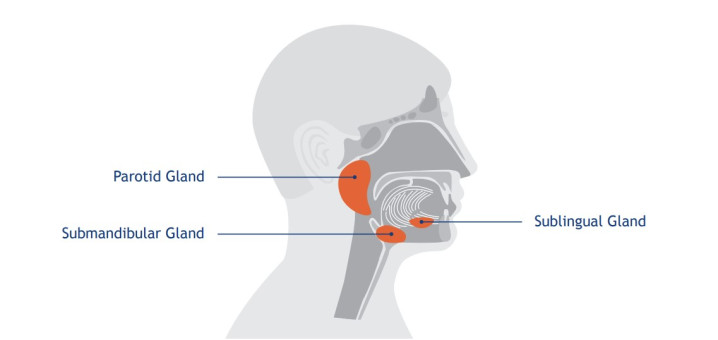
New Zealand has a very high rate of both melanoma and non-melanoma skin cancer. The head and neck area is commonly affected due to regular exposure to the sun, often without any skin protection.
Some skin cancers can spread (metastasise) to other parts of the head and neck, such as the lymph nodes and the parotid gland.
The thyroid gland is located low in the central neck, below the voice box (larynx) and in front of the windpipe. It produces a hormone called thyroxine. Thyroxine helps to regulate your weight, body temperature, growth, and development.
Cancers that start in the thyroid gland are often lower grade and grow more slowly than other head and neck cancers. There are some higher-grade, faster-growing types of thyroid cancer, but these are rare.
© Cancer Research UK [2002] All rights reserved. Information taken 2023
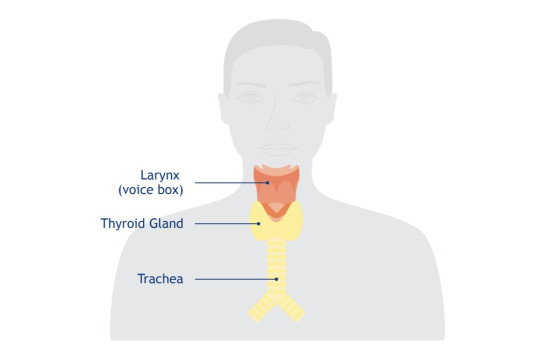
Types of head and neck cancer
Cancers of the head and neck are also named by the type of cell where the cancer first started to grow.
| Squamous cell carcinoma (SCC) |
Cancer that starts in the cells that line the surfaces of the mouth, nose, throat or skin. |
Most common (90%) |
| Lymphoma | Cancer that grows in the lymphatic system (immune system) and travels to your lymph nodes in your head and neck. |
Common See more |
| Melanoma | Cancer that grows in the cells that give colour to your skin and eyes. Melanoma can also start in the cells that line the mouth. |
Uncommon See more information on melanoma here. |
| Adenocarcinoma | Cancer that starts in the glands of the head and neck. |
Rare |
| Sarcoma | Cancer that grows in the blood vessels, cartilage, or muscles in the head and neck. |
Very rare See more information on sarcoma here. |
What are the risk factors for head and neck cancer?
Anything that can increase your chance of developing cancer is called a risk factor.
Some risk factors can be changed, such as not smoking. Some risk factors cannot be changed, such as having a strong family history of cancer.
Having one or more risk factor does not mean that you or your whānau will develop cancer. Most people have at least one risk factor but will never develop cancer. Others with cancer may have no known risk factors.
Risk factors that we know make some people more at risk than others for head and neck cancer include the following:
- Chewing tobacco or betel nut (araca and gutka) increases the risk
of developing mouth cancer. - Contact with certain chemicals and dusts through workplaces can
increase the risk of throat cancer (oropharyngeal). - Head and neck cancers are more common in men than in women.
- Head and neck cancer is more common in people over the age of
50. However, younger people can be affected too. - HPV can increase the risk of cancers in the tongue, tonsil, and
throat (oropharynx). - If you drink a lot of alcohol (more than 10 standard drinks a week)
you increase your risk of developing head and neck cancer.
If you smoke and drink alcohol, the risk is even greater. - Smoking tobacco is the number one risk factor for head and neck
cancer. It includes smoking cigarettes, cigars, and pipes. The more
you smoke, the greater the risk.
People who do not smoke can also get head and neck cancer, but
their risk is much lower.
The long-term health impacts of vaping are unknown.
HPV is a group of common viruses that affect the surfaces of different areas of the body, including the throat, cervix, and skin. There are many types of HPV, and most people will be infected at some stage in their lives but will never know that they have had an HPV infection.
Most types of HPV are not linked to cancer. It is important to know that most people infected by HPV do not develop cancer. Usually, the body’s immune system gets rid of the virus.
However, some forms of HPV (mainly HPV 16 and HPV 18) increase the risk of developing cancer of the throat (oropharynx). These are called HPV positive head and neck cancers.
HPV immunisation began in New Zealand in 2008. HPV immunisation is free for everyone aged 9 to 26, and for non-residents under the age of 18.More information about vaccination against HPV
Symptoms of head and neck cancer
The symptoms of head, neck, and mouth cancer depend on where the cancer is. In its early stages, head and neck cancer may have no symptoms. Cancer that begins in the head or neck usually spreads to lymph nodes in the neck before it spreads elsewhere.
A lump (or lumps) in the neck can be the first sign of cancer of the mouth, nose, throat, voice box (larynx), or thyroid gland. These lumps are generally painless and may slowly get bigger. Some people feel very tired (fatigue) when cancer is growing.
Common symptoms of head and neck cancer
- Mouth pain or pain swallowing
- A sore or swelling that does not go away
- Unusual bleeding or numbness
- Red or white patches on the gums, tongue, or mouth
- Bad breath
- Changes in speech (difficulty pronouncing words)
- Difficulty chewing or swallowing food
- Losing weight without trying
- A lump in the neck
- Loose teeth, or dentures (false teeth) that no longer fit
- Earache or ringing in the ears
- Decreased sense of smell
- A blocked nose (especially on one side) that does not go away, or a blocked ear
- Regular nosebleeds
- Increased mucus (snot) in the back of the nose or throat
- Regular headaches
- Difficulty swallowing
- Loose or sore upper teeth
- A lump in the nose or mouth, or on the face
- Pressure or pain in the ears
- A watering or bulging eye
- Double vision
- Loss of sight (vision). Can be complete or partial
- A lump or swelling near the ear, jaw, or lip, or inside the mouth
- Sides of the face and neck look different
- Difficulty in opening the mouth wide, or finding it hard to swallow
- Weakness, drooping, or numbness on one side of the face (palsy)
- Throat pain or difficulty swallowing
- A sore throat or cough that does not go away
- Coughing up blood
- Bad breath
- Losing weight without trying
- A change in the sound of the voice that does not go away
- Dull pain in the chest
- A lump in the neck
- Pain in the ear, or regular ear infections
- Feeling unable to able to breathe properly
- Numbness in the face
- Blocked nose
- Loss of hearing
- Headaches
- A lump or swelling in the neck or throat
- A sore throat that does not go away
- A change in the sound of the voice that does not go away
- Difficulty or pain when swallowing
- Constant coughing
- Feeling unable to breathe properly
- Losing weight without trying
- Pain in the ear
- An ulcer or sore that does not heal
- Crusting or bleeding of an area of skin
- Swelling of the thyroid gland (goitre)
- Swelling of the lymph nodes in the neck
- Change in voice
- Problems with swallowing or breathing
- Pain in the front of the neck or throat
- A cough that does not go away
These symptoms can be caused by reasons other than cancer. That is why it is important to have any of these symptoms checked by your GP or whānau doctor.
